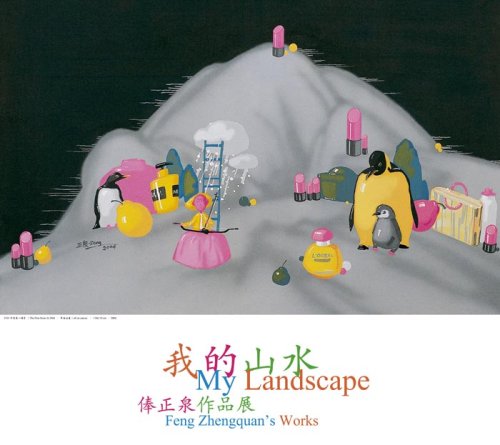8/4/2005
Feng Zhenquan
Top Space, Beijing
Feng Zhenquan. About 30 paintings from the last two years. The vertical layout of his paintings reminds people of traditional folding screens. Removed from the context of traditional Chinese paintings, the blurry, typical ancient landscapes appear very abstract and conceptual.

My Landscape
When I first met Feng Zhenquan years ago, he was still working on his “Face†series. The square paintings look like a glass window against which, a boy’s face is pressed, deformed by deliberate squeezing. Though deformed, it is not contorted or oppressed. It just tries to let you know his uncomfortable and uneasy feelings in an exaggerated and mischievous way. He painted his own face but described the psychological state of the new generation as well as their confusion and agony when growing up and facing reality.
The exhibition to be held at Top Space will be the first formal solo exhibition in China for Feng Zhengquan. Starting with a new series — “My Landscape†— from 2003, he will present about 30 paintings from the last two years. The vertical layout of his paintings reminds people of traditional folding screens. Removed from the context of traditional Chinese paintings, the blurry, typical ancient landscapes in Feng’s paintings appear very abstract and conceptual. They seem to be traditional landscapes, with water encircling mountains, but the classical landscapes become blurred in the “contemporary†view and are no longer the visual focus, possibly due to the close distance or the audience’s illusion of being inside the scene. In the grayness, the landscapes lose their clear and defined outlines and fade into the background of the painting. In the foreground, a great variety of everyday consumer goods pop up, such as fashionably designed bags, perfume and lipsticks, with names and logos that mimic famous international brands. They are randomly scattered without order or arrangement. Mountains, cliffs, valleys, riverbanks, far or near, all appear real and vivid. But all living things such as children, birds, penguins and flowers have lost their natural attributes in this commodity-filled atmosphere and appear like cartoons. It is as if the power of decoration and manufacturing has overwhelmed the creations of nature. Cars, fruits, children and lipsticks are all the same size in this world. In the paintings, the indications of modern life in the foreground float on the landscape background as though they have been blown in by a sudden storm, and may be blown off again by a subsequent storm. Only at this moment, both are overlapped in a conflicting and disharmonious way. Compared with the traditional landscape, the fashionable items look like trash scattered over the mountains; in contrast, the background makes the fashionable items appear more striking, beautiful and brilliant. They form a weird family without any spiritual connection or blood ties.
Feng Zhengquan’s landscape is contradictory. It can be regarded either as a literati landscape or as a natural landscape. The reason why it is a literati’s landscape is that it originates from those ancient masterpieces that reflect the dreams of the celebrated literati, as well as their aspirations of becoming a hermit and standing aloof from worldly affairs. The reason why it is also a natural landscape is that it represents a real state, showing the confusion that exists between tradition and reality in our present environment. “Standing aloof from worldly affairs†seemed to be the ultimate and only way out for traditional Chinese literati, quite a different approach to modern intellectuals who advocate “getting involved and participating in societyâ€. Unifying the two states of literati landscape and natural landscape Feng Zhengquan’s landscape thus appears very ambiguous, and also reveals the sad complex of modern intellectuals, who actively participate in society but can never rid themselves of the dream of turning their back on the world and living as a hermit. Therefore, Feng Zhengquan’s “Landscape†is pessimistic, fatalistic, sad and helpless.
Compared with his “Face†series, Feng Zhengquan’s art has gone from the simple expression of personal life experiences to a concern with the external living environment. The seemingly lively “My Landscape†and “My Life†constantly remind us of the huge difference between Western commercial culture, a sub-culture which has threatened the traditional mainstream, and the local traditional culture. Unlike the last generation of artists who bore tough life experiences and a serious cultural mission, the young artist interprets his personal perceptions and connects them with relevant issues in an easy and humorous way. Rather than merely taking a critical attitude towards reality, Feng Zhengquan is more concerned with making a subjective examination of his personal daily life and pondering the fate of traditional culture in contemporary reality.
If we say that intellectuals in the 80s who composed epics in their Utopian pursuit of a spiritual world were solemn and stirring, and that artists in the 90s who recorded existential realities were cruel and merciless, then exile from spiritual pursuits and the oppression of reality has lead the cartoon generation to find their own space within specific and concrete scenarios. Feng Zhengquan’s landscape is microcosmic; his “Landscape†can be as big as the world or as small as a residence, a spiritual residence that is confusing and uncertain as to the destination of the heart. Facing a life that still cannot be ordered and questions that cannot be answered, in his paintings he shows his efforts to seek his own identity in his individual environment. He sees himself as an adult but still hopes to retain his childishness. This childishness is fully represented through his cartoon-style painting language. “Cartoon†is a point of interest, that draws our attention to the specific, the detailed, the microcosmic and the partial – everything can be found within the landscape.
Tang Xin
Top Space
11/F, Taikang Life Building, No.156 Fuxingmennei Daijie
Beijing



